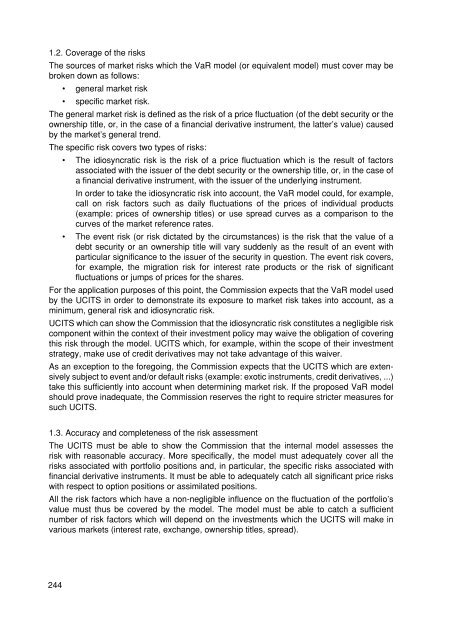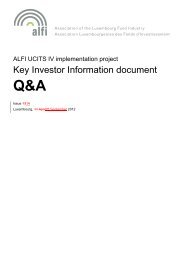law of 20 December 2002 - Alfi
law of 20 December 2002 - Alfi
law of 20 December 2002 - Alfi
- No tags were found...
You also want an ePaper? Increase the reach of your titles
YUMPU automatically turns print PDFs into web optimized ePapers that Google loves.
1.2. Coverage <strong>of</strong> the risksThe sources <strong>of</strong> market risks which the VaR model (or equivalent model) must cover may bebroken down as follows:• general market risk• specific market risk.The general market risk is defined as the risk <strong>of</strong> a price fluctuation (<strong>of</strong> the debt security or theownership title, or, in the case <strong>of</strong> a financial derivative instrument, the latter’s value) causedby the market’s general trend.The specific risk covers two types <strong>of</strong> risks:• The idiosyncratic risk is the risk <strong>of</strong> a price fluctuation which is the result <strong>of</strong> factorsassociated with the issuer <strong>of</strong> the debt security or the ownership title, or, in the case <strong>of</strong>a financial derivative instrument, with the issuer <strong>of</strong> the underlying instrument.In order to take the idiosyncratic risk into account, the VaR model could, for example,call on risk factors such as daily fluctuations <strong>of</strong> the prices <strong>of</strong> individual products(example: prices <strong>of</strong> ownership titles) or use spread curves as a comparison to thecurves <strong>of</strong> the market reference rates.• The event risk (or risk dictated by the circumstances) is the risk that the value <strong>of</strong> adebt security or an ownership title will vary suddenly as the result <strong>of</strong> an event withparticular significance to the issuer <strong>of</strong> the security in question. The event risk covers,for example, the migration risk for interest rate products or the risk <strong>of</strong> significantfluctuations or jumps <strong>of</strong> prices for the shares.For the application purposes <strong>of</strong> this point, the Commission expects that the VaR model usedby the UCITS in order to demonstrate its exposure to market risk takes into account, as aminimum, general risk and idiosyncratic risk.UCITS which can show the Commission that the idiosyncratic risk constitutes a negligible riskcomponent within the context <strong>of</strong> their investment policy may waive the obligation <strong>of</strong> coveringthis risk through the model. UCITS which, for example, within the scope <strong>of</strong> their investmentstrategy, make use <strong>of</strong> credit derivatives may not take advantage <strong>of</strong> this waiver.As an exception to the foregoing, the Commission expects that the UCITS which are extensivelysubject to event and/or default risks (example: exotic instruments, credit derivatives, ...)take this sufficiently into account when determining market risk. If the proposed VaR modelshould prove inadequate, the Commission reserves the right to require stricter measures forsuch UCITS.1.3. Accuracy and completeness <strong>of</strong> the risk assessmentThe UCITS must be able to show the Commission that the internal model assesses therisk with reasonable accuracy. More specifically, the model must adequately cover all therisks associated with portfolio positions and, in particular, the specific risks associated withfinancial derivative instruments. It must be able to adequately catch all significant price riskswith respect to option positions or assimilated positions.All the risk factors which have a non-negligible influence on the fluctuation <strong>of</strong> the portfolio’svalue must thus be covered by the model. The model must be able to catch a sufficientnumber <strong>of</strong> risk factors which will depend on the investments which the UCITS will make invarious markets (interest rate, exchange, ownership titles, spread).244
















